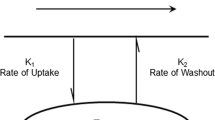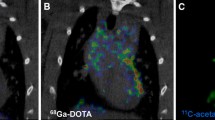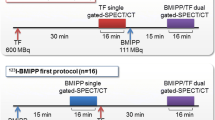Abstract
Purpose
99 mTcN-MPO ([99 mTcN(mpo)(PNP5)]+: mpo = 2-mercaptopyridine oxide and PNP5 = N-ethoxyethyl-N,N-bis[2-(bis(3-methoxypropyl)phosphino)ethyl]amine) is a cationic 99 mTc-nitrido complex, which has favorable biodistribution and myocardial uptake with rapid liver clearance in Sprague Dawley rats. The objective of this study was to compare the biodistribution and pharmacokinetics of 99 mTcN-MPO and 99 mTc-Sestamibi in normal dogs, and to evaluate the potential of 99 mTcN-MPO as a myocardial perfusion agent in canines with acute myocardial infarction.
Methods
Five normal mongrel dogs were injected intravenously with 99 mTcN-MPO. Venous blood samples were collected via a femoral vein catheter at 0.5, 1, 2, 3, 4, 5, 10, 20, 30, 40, 60, and 90 min post-injection (p.i.). Anterior-posterior planar images were acquired by γ-camera at 10, 20, 30, 60, 90, and 120 min p.i. Regions of interest (ROIs) were drawn around the heart, liver, and lungs. The heart/liver and heart/lung ratios were calculated by dividing the mean counts in heart ROI by the mean counts in the liver and lung ROI, respectively. For comparison, 99 mTc-sestamibi was also evaluated in the same five dogs. The interval period between the two examinations was 1 week to eliminate possible interference between these two radiotracers. In addition, single positron emission computed tomography (SPECT) images in the canine infarct model were collected 24 h after myocardial infarction at 30 and 60 min after the administration of 99 mTcN-MPO (n = 4) or 99 mTc-Sestamibi (n = 4).
Results
It was found that 99 mTcN-MPO and 99 mTc-Sestamibi displayed very similar blood clearance characteristics during the first 90 min p.i. Both 99 mTcN-MPO and 99 mTc-Sestamibi had a rapid blood clearance with less than 50% of initial radioactivity remaining at 1 min and less than 5% at 30 min p.i. 99 mTcN-MPO and 99 mTc-Sestamibi both showed good heart/lung contrast. The heart/liver ratio of 99 mTcN-MPO increased with time (0.53 ± 0.06 at 10 min, 0.90 ± 0.062 at 30 min, and 1.22 ± 0.06 at 60 min p.i.), whereas the heart/liver ratio of 99 mTc-Sestamibi remained low at all time points (0.50 ± 0.03 at 10 min, 0.64 ± 0.03 at 30 min, and 0.60 ± 0.02 at 60 min p.i.). SPECT imaging studies in canines with acute myocardial infarction indicated that good visualization of the left ventricular wall and perfusion defects could be achieved at 30 min after administration of 99 mTcN-MPO but not after 99 mTc-Sestamibi.
Conclusion
The combination of reasonable heart uptake with rapid hepatobiliary excretion makes 99 mTcN-MPO a promising new radiotracer for myocardial perfusion imaging.







Similar content being viewed by others
References
Beller GA, Zaret BL (2000) Contributions of nuclear cardiology to diagnosis and prognosis of patients with coronary artery disease. Circulation 101:1465–1478
Jain D (1999) Technetium-99 m labeled myocardial perfusion imaging agents. Semin Nucl Med 29:221–236
Llaurado JG (2001) The quest for the perfect myocardial perfusion indicator...still a long way to go. J Nucl Med 42:282–284
Kailasnath P, Sinusas AJ (2001) Comparison of Tl-201 with Tc-99 m-labeled myocardial perfusion agents: technical, physiologic, and clinical issues. J Nucl Cardiol 8:482–498
Banerjee S, Pillai MR, Ramamoorthy N (2001) Evolution of Tc-99 m in diagnostic radiopharmaceuticals. Semin Nucl Med 31:260–277
Liu S (2007) Ether and crown ether-containing cationic 99 mTc complexes useful as radiopharmaceuticals for heart imaging. Dalton Trans 12:1183–1193
Lisic EC, Heeg MJ, Deutsch E (1999) 99 mTc(L-L) +3 complexes containing ether analogs of DMPE. Nucl Med Biol 26:563–571
Tisato F, Maina T, Shao LR et al. (1996) Cationic [99 mTcIII(DIARS)2(SR)2]+ complexes as potential myocardial perfusion imaging agents (DIARS = o-phenylenebis(dimethylarsine); SR = thiolate). J Med Chem 39:1253–1261
Boschi A, Bolzati C, Uccelli L et al. (2002) A class of asymmetrical nitrido 99 mTc heterocomplexes as heart imaging agents with improved biological properties. Nucl Med Commun 23:689–693
Hatada K, Riou LM, Ruiz M et al. (2004) 99 mTc-N-DBODC5, a new myocardial perfusion imaging agent with rapid liver clearance: comparison with 99 mTc-sestamibi and 99 mTc-tetrofosmin in rats. J Nucl Med 45:2095–2101
Hatada K, Ruiz M, Riou LM et al. (2006) Organ biodistribution and myocardial uptake, washout, and redistribution kinetics of Tc-99 m N-DBODC5 when injected during vasodilator stress in canine models of coronary stenoses. J Nucl Cardiol 13:779–790
Kim YS, He Z, Hsieh WY et al. (2006) A novel ternary ligand system useful for preparation of cationic 99 mTc-diazenido complexes and 99 mTc-labeling of small biomolecules. Bioconjug Chem 17:473–484
Liu S, He Z, Hsieh WY et al. (2006) Evaluation of novel cationic 99 mTc-nitrido complexes as radiopharmaceuticals for heart imaging: improving liver clearance with crown ether groups. Nucl Med Biol 33:419–432
He Z, Hsieh WY, Kim YS et al. (2006) Evaluation of novel cationic 99 mTc(I)-tricarbonyl complexes as potential radiotracers for myocardial perfusion imaging. Nucl Med Biol 33:1045–1053
Kim YS, He Z, Hsieh WY et al. (2007) Impact of bidentate chelators on lipophilicity, stability, and biodistribution characteristics of cationic 99 mTc-nitrido complexes. Bioconjug Chem 18:929–936
Cittanti C, Uccelli L, Pasquali M et al. (2008) Whole-body biodistribution and radiation dosimetry of the new cardiac tracer 99 mTc-N-DBODC. J Nucl Med 49:1299–1304
Kim YS, Wang J, Broisat A et al. (2008) Tc-99 m-N-MPO: novel cationic Tc-99 m radiotracer for myocardial perfusion imaging. J Nucl Cardiol 15:535–546
Kim YS, Shi J, Zhai S et al. (2009) Mechanism for myocardial localization and rapid liver clearance of Tc-99 m-N-MPO: a new perfusion radiotracer for heart imaging. J Nucl Cardiol4:571–579
Fang W, Liu Y, Zhu L et al. (2008) Evaluation of 99 mTcN-15C5 as a new myocardial perfusion imaging agent in normal dogs and canines with coronary stenosis. Nucl Med Commun 29:775–781
Krejcy K, Krumpl G, Todt H et al. (1992) Lidocaine has a narrow antiarrhythmic dose range against ventricular arrhythmias induced by programmed electrical stimulation in conscious postinfarction dogs. Naunyn Schmiedebergs Arch Pharmacol 346:213–218
Dib N, Diethrich EB, Campbell A et al. (2006) A percutaneous swine model of myocardial infarction. J Pharmacol Toxicol Methods 53:256–263
Katori R, Yamashita K, Miyazaki T et al. (1995) Beta-adrenergic stimulation induces ST-segment elevation in dogs with healing myocardial infarction. Tohoku J Exp Med 177:233–248
Chua T, Kiat H, Germano G et al. (1993) Rapid back to back adenosine stress/rest technetium-99 m teboroxime myocardial perfusion SPECT using a triple-detector camera. J Nucl Med 34:1485–1493
Berman DS, Germano G, Shaw LJ (1999) The role of nuclear cardiology in clinical decision making. Semin Nucl Med 29:280–297
Acampa W, Di Benedetto C, Cuocolo A (2000) An overview of radiotracers in nuclear cardiology. J Nucl Cardiol 7:701–707
Lee CH, Bradley G, Zhang JT et al. (1993) Differential expression of P-glycoprotein genes in primary rat hepatocyte culture. J Cell Physiol 157:392–402
Mayer R, Kartenbeck J, Buchler M et al. (1995) Expression of the MRP gene-encoded conjugate export pump in liver and its selective absence from the canalicular membrane in transport-deficient mutant hepatocytes. J Cell Biol 131:137–150
Agrawal M, Abraham J, Balis FM et al. (2003) Increased 99mTc-sestamibi accumulation in normal liver and drug-resistant tumors after the administration of the glycoprotein inhibitor, XR9576. Clin Cancer Res 9:650–656
Gatmaitan ZC, Arias IM (1993) Structure and function of P-glycoprotein in normal liver and small intestine. Adv Pharmacol 24:77–97
Qadir M, O'Loughlin KL, Fricke SM et al. (2005) Cyclosporin A is a broad-spectrum multidrug resistance modulator. Clin Cancer Res 11:2320–2326
van Dongen AJ, van Rijk PP (2001) Minimizing liver, bowel, and gastric activity in myocardial perfusion SPECT. J Nucl Med 41: 1315–1317
Acknowledgments
This work was supported, in part, by the following research grants: 2009DFB30040 from the international cooperation projects of the Chinese Ministry of Science and Technology, 20070420165 from the National Science Foundation for Postdoctoral Scientists of China, 2007AA3CS085 from the Science and Technology Tackle Key Problem Plan Foundation of Harbin. The authors wish to thank Drs. Fan Wang and Bing Jia from Peking University for technical support.
Author information
Authors and Affiliations
Corresponding authors
Additional information
Lihong Bu and Renfei Li contributed equally to this work
Rights and permissions
About this article
Cite this article
Bu, L., Li, R., Jin, Z. et al. Evaluation of 99 mTcN-MPO as a New Myocardial Perfusion Imaging Agent in Normal Dogs and in an Acute Myocardial Infarction Canine Model: Comparison with 99 mTc-Sestamibi. Mol Imaging Biol 13, 121–127 (2011). https://doi.org/10.1007/s11307-010-0304-2
Published:
Issue Date:
DOI: https://doi.org/10.1007/s11307-010-0304-2




